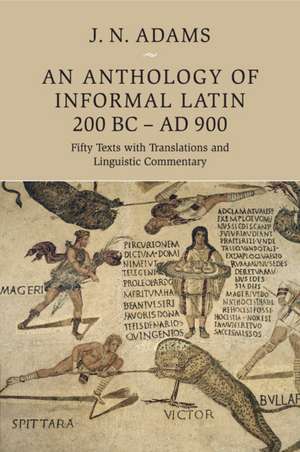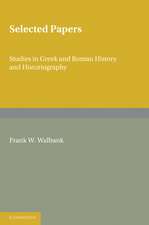An Anthology of Informal Latin, 200 BC–AD 900: Fifty Texts with Translations and Linguistic Commentary
Editat de J. N. Adamsen Limba Engleză Paperback – 23 ian 2019
| Toate formatele și edițiile | Preț | Express |
|---|---|---|
| Paperback (1) | 258.31 lei 3-5 săpt. | +36.98 lei 7-13 zile |
| Cambridge University Press – 23 ian 2019 | 258.31 lei 3-5 săpt. | +36.98 lei 7-13 zile |
| Hardback (1) | 1256.15 lei 6-8 săpt. | |
| Cambridge University Press – 25 sep 2016 | 1256.15 lei 6-8 săpt. |
Preț: 258.31 lei
Nou
Puncte Express: 387
Preț estimativ în valută:
49.43€ • 51.79$ • 40.86£
49.43€ • 51.79$ • 40.86£
Carte disponibilă
Livrare economică 21 martie-04 aprilie
Livrare express 07-13 martie pentru 46.97 lei
Preluare comenzi: 021 569.72.76
Specificații
ISBN-13: 9781108729970
ISBN-10: 1108729975
Pagini: 731
Dimensiuni: 150 x 218 x 36 mm
Greutate: 0.96 kg
Editura: Cambridge University Press
Colecția Cambridge University Press
Locul publicării:Cambridge, United Kingdom
ISBN-10: 1108729975
Pagini: 731
Dimensiuni: 150 x 218 x 36 mm
Greutate: 0.96 kg
Editura: Cambridge University Press
Colecția Cambridge University Press
Locul publicării:Cambridge, United Kingdom
Cuprins
Preface; Introduction; Abbreviations; Texts; 1. Ennius Euhemerus III (Vahlen); 2. Plautus Miles Gloriosus 5-27; 3. Plautus Miles Gloriosus 416-35; 4. Cato De agricultura 33.5-35; 5. Cato De agricultura 157.3-7; 6. One of the Johns Hopkins defixiones ('Plotius'), of republican date (c. 100 BC?); 7. Rhetorica ad Herennium 4.14: a specimen of the 'simple style'; 8. Rhetorica ad Herennium 4.16: a 'debased' variant of the 'simple style'; 9. Letter of Marcus Caelius Rufus to Cicero (Fam. 8.15.1-2); 10. Some jokes recorded by Cicero, Quintilian and Macrobius, mainly of republican date; 11. Vitruvius on the larch (2.9.14-16); 12. From a letter of Augustus (Suetonius Aug. 76.2); 13. Soldier's letter of the late first century BC (Augustan period) from Qasr Ibrîm Egypt (P. Rainer Cent. 164, CEL 9); 14. Letter from Oxyrhynchus, possibly of Augustan date (Brown 1970, P. Oxy. XLIV.3208); 15. Legal document from the archive of the Sulpicii (TPSulp. 51: Camodeca 1999), dated 18 June AD 37 at Puteoli; 16. Sexual verses from Pompeii (CIL IV.2360, 4008, 8229); 17. Passage from a letter of Seneca (12.1-3); 18. Freedman's speech from the Satyrica of Petronius (37.1-38.2); 19. Curse tablet from the sanctuary of Isis and Mater Magna at Mainz (Blänsdorf 2010a: 173-5, text no. 8), of the second half of the first century AD; 20. Letter from the Myos Hormos road (Egypt), end of first century/first quarter of second (Cuvigny 2003: II.409, M689); 21. Letter of Claudia Severa from Vindolanda (Tab. Vindol. 292), of the early second century; 22. Letter of Claudius Terentianus (P. Mich. VIII.471, CEL 146), of the early second century; 23. Letter from Mons Claudianus (Egypt), of the second century (O. Claud. 367); 24. Another letter from the Myos Hormos road (Egypt), of the period of Hadrian (Cuvigny 2003: II.405, M1107); 25. Surveyor's inscription from Algeria (CIL VIII.2728 = 18122 = ILS 5795), commemorating the construction of an aqueduct, c. 153; 26. Soldier's letter from Wâdi Fawâkhir (Egypt), possibly of the second century (O. Faw. 2, CPL 304, CEL 74); 27. Passio sanctarum Perpetuae et Felicitatis 10, of the early third century; 28. The Magerius Mosaic (third century); 29. Pelagonius Ars ueterinaria 34 (fourth century); 30. Parts of Pelagonius Ars ueterinaria 404, from two different manuscripts; 31. Letter of Publicola to Augustine (Aug. Epist. 46, CSEL 34); 32. Curse tablet from London Bridge (Hassall and Tomlin 1987: 360-1 no. 1); 33. Curse tablet from the Hamble Estuary, Hampshire (Tomlin 1997: 455 no. 1); 34. Curse tablet from Uley, Gloucestershire (Hassall and Tomlin 1996: 440 no. 1); 35. Another curse tablet from Uley, Gloucestershire (Hassall and Tomlin 1992: 311 no. 5); 36. Curse tablet from Ratcliffe-on-Soar, Nottinghamshire (Hassall and Tomlin 1993: 312 no. 2); 37. Curse tablet from Leicester (Tomlin 2008, 2009: 327 no. 21); 38. Gospel of John (6.51-69) from the Vetus Latina (Codex Palatinus, e), and the corresponding passage from the Vulgate; 39. Patrick Confessio 42-3 (fifth century); 40. Patrick Confessio 48-9; 41. From one of the Albertini Tablets (Tablettes Albertini XIV.1-9), of the late fifth century; 42. Two versions of a passage from the Physica Plinii; 43. Two versions of Historia Apollonii Regis Tyri 40.1-15; 44. Itinerarium Antonini Placentini 36-7, with different versions; 45. Passage from the Dialogues of Gregory the Great (1.2.2-3); 46. Visigothic slate tablet (Velázquez Soriano 2004, 40.II), of the first half of the seventh century; 47. Passage from the Vita sanctae Euphrosynae (17); 48. Selected passages from the Annales regni Francorum, in two versions; 49. A description of the Basilica of Saint-Denis of 799; 50. A tenth-century treatise on falcon medicine from northern Italy; Final conclusions; Bibliography; Subject index; Index verborum.
Descriere
This book illustrates the changing character of Latin over 1000 years, through detailed linguistic commentaries on fifty passages, each with a translation.















